Measuring topical authority: Tools, tips, examples, and prompts
Topic: SEO
Published:
Written by: Bernard Huang
Here's a quick overview of what you'll cover in this article.
Ways to measure topical authority—tips from industry leaders
When I first started working in content marketing and SEO years ago, “topical authority” wasn’t even on our radar.
Now, it’s a key piece of any SEO strategy that focuses on delivering high-quality content and securing higher rankings in search engine results pages (SERPs).
But measuring it? That’s where things get tricky.
Unlike traditional metrics or KPIs—like backlinks, organic traffic, conversions, or domain authority—topical authority feels like more art than science at times.
However, if you’re talking about it as part of your overall approach to content marketing and SEO, you bet your stakeholders are going to want to see it measured.
I’m going to help you out here.
In this guide, you’ll get:
Several ways you can represent topical authority share through data, to make your reporting life a bit easier
Proven methods to think through topical authority measurement, using insights from some of the industry’s most trusted voices—Kevin Indig, Ahrefs, Moz, SEOwind, and Bernard Huang—to guide the way.
My own favorite trick I’ve used in the past to quantify topical authority for stakeholders (you can use this approach with almost any SEO tool).
A few ways you can analyze your site’s topical authority with the help of AI tools, like ChatGPT or Claude.
As search engines, AI platforms, and social media continues to refine and change algorithms over time, becoming a trusted source on a specific topic is more important than ever.
So how can you reliably measure your website’s topical authority and track progress over time?
Let’s dive into a few ways...

Topic share: Your share of traffic in your topic (Kevin Indig)
According to Kevin Indig, the easiest way to measure topical authority is by analyzing the share of traffic a site garners from a specific topic.
He refers to this as "topic share" in his June 20, 2022, newsletter (that you should read), drawing a parallel to market share.
The concept is straightforward: The more traffic a site receives from keywords related to a specific topic, the more authoritative it is perceived to be for that topic.
Measuring topical authority from this perspective makes sense because it takes two factors into account:
User perception: The links users choose to click on reflect their perception of a website or brand’s authority on the subject. This demonstrates how real people trust and recognize the site or brand’s expertise in the topic.
Search engine perception: What search engines serve to users—ultimately, what they see on the first page—is influenced by their understanding of a site’s topical authority. This shows how well the site’s content aligns with search engine algorithms that evaluate expertise and relevance for a particular subject.
By using Kevin Indig’s topic share idea, you can evaluate how well a site dominates a particular topic in terms of search traffic, which in turn reflects its authority in that niche.
Kevin specifically uses Ahrefs to measure topic share. (More on that below!)
Overall, this method moves beyond keyword ranking to consider the bigger picture of overall topical relevance. Which is crucial.
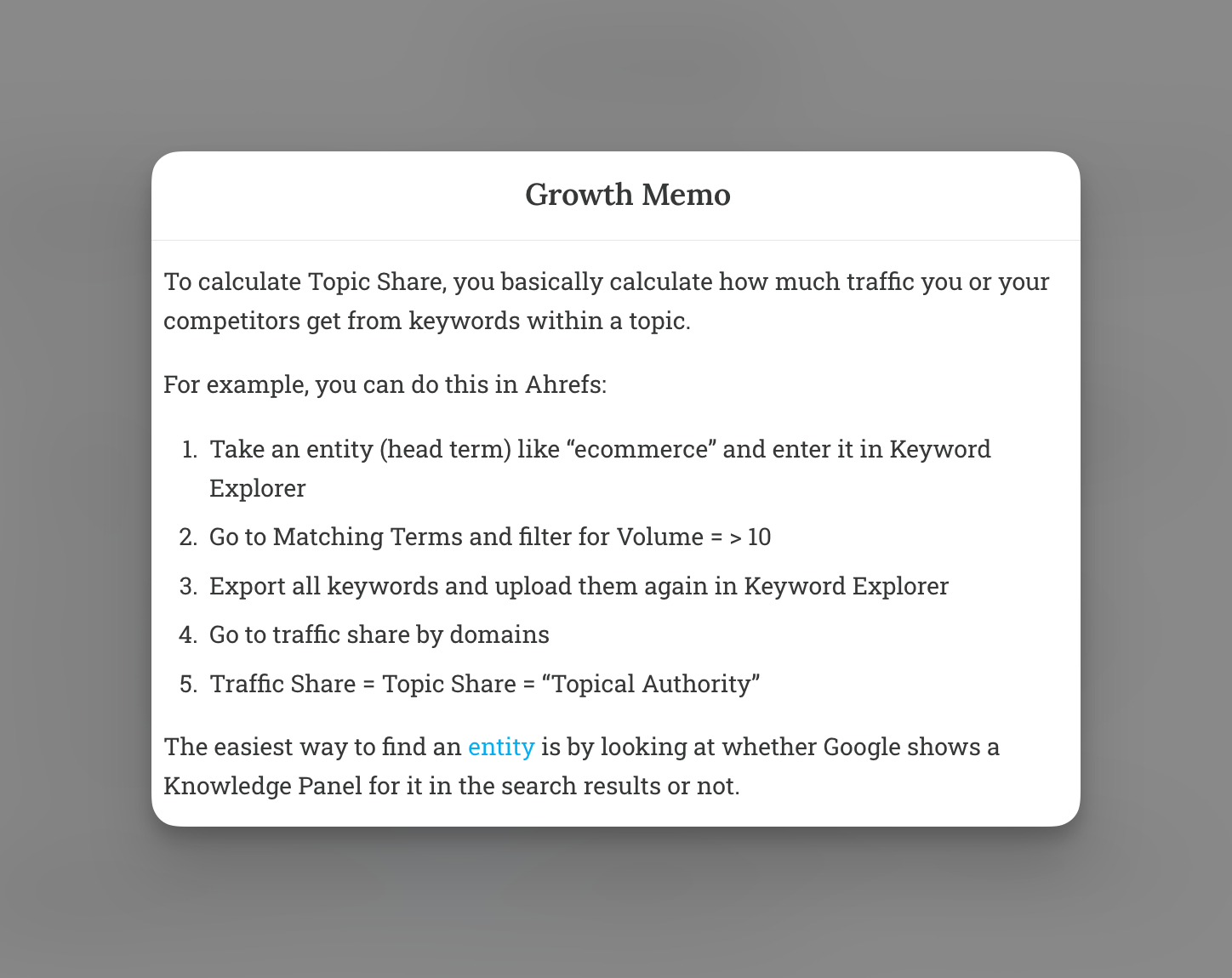
From Kevin Indig's Growth Memo: June 20, 2022
Traffic share as a metric (Ahrefs)
If you use Kevin’s Ahrefs method, one of the ways you can start measuring topical authority is by looking at your traffic share.
Ahrefs has a feature called Keyword Explorer—basically a traditional SEO keyword research tool—that also allows you to see the estimated traffic share by domain, which is an indicator of how well your site is performing for relevant keywords in your main topic or subtopics compared to your competitors.
As far as traffic share goes, the higher your slice of the organic pie, the more topical authority you’ve built.
By using traffic share as a baseline metric, you can understand your current level of perceived authority and set measurable goals for future growth.
Brand authority and social proof (Moz)
Another way to think about topical authority is through brand authority, which Moz explores in detail in this post.
But brand authority isn’t exactly the same thing as topical authority.
However, this metric developed by Moz, paired with their domain authority metric, can give your stakeholders a sense of where your site measures up compared to your competitors.
And brand authority isn’t just about search rankings; it’s about how searchers and content creators perceive you in your niche.
Building brand trust is key to building topical authority—they overlap and support one another.
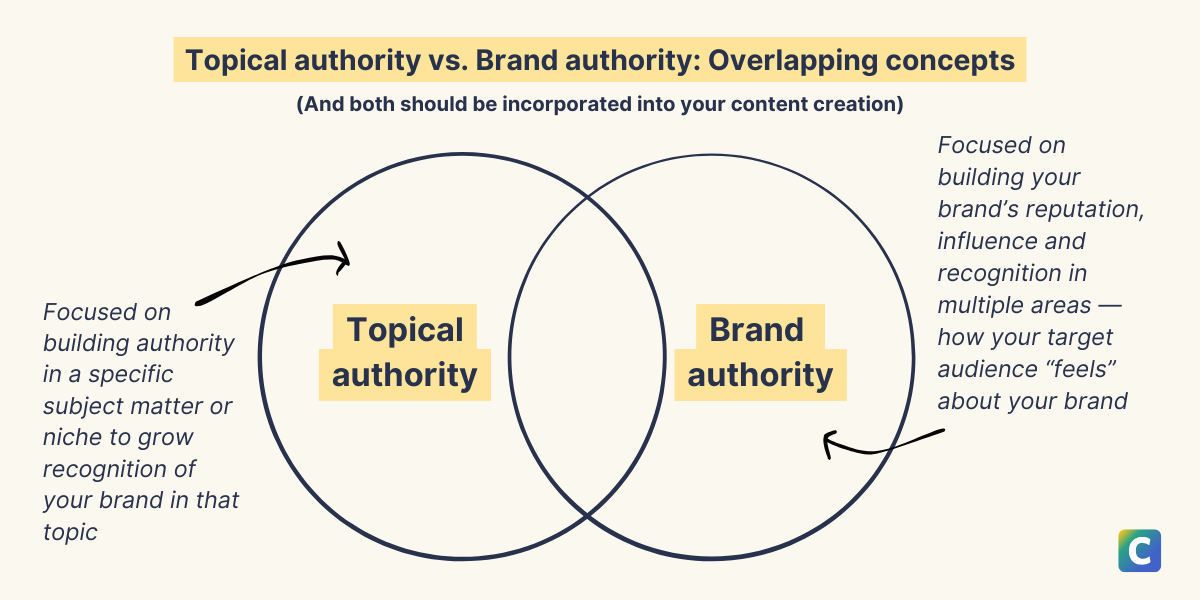
Topical authority vs. brand authority: How they overlap
Things like positive brand mentions, strong social media presence, and quality backlinks from authoritative websites can reinforce your topical relevance in Google’s algorithm.
Moz also highlights that E-E-A-T (Expertise, Experience, Authoritativeness, and Trustworthiness) plays a significant role in helping search engines measure your topical authority.
Topical Authority Ratio (SEOwind)
SEOwind has introduced an interesting metric called the topical authority ratio, which measures how much content a site produces for a specific subject matter versus how well it performs in the SERPs.
Basically, the ratio is the following:
Topical Authority Ratio = [# of pages on the topic in question]/[number of total pages of content]
How this works:
Let’s say Clearscope has recently started focusing on the topic of keyword research. For example, out of our 100 total pages, 15 are dedicated to high-quality content about keyword research.
That looks like:
Topical Authority Ratio = 15/100 = .15 or 15%
In theory, if your team had a goal of increasing your site’s internal topical authority in a topic, you’d want to increase the ratio of pages about that topic.
The topical authority ratio is one way to understand the relationship between your content creation efforts and the organic search performance you’re achieving.
For instance, if you’ve written extensively about a specific subject across your content strategy efforts but aren’t seeing the rankings, it may indicate that your content isn’t as authoritative or optimized as it could be.
And that would mean it’s time to go back to the digital marketing drawing board to see what’s causing this issue.
A few things to think through:
Are you practicing healthy internal link building strategies? (Clearscope can help you do this efficiently.)
Have you used outdated SEO practices, like stuffing keywords and related keywords into a single piece of content or a giant pillar page, rather than building systems or topic clusters of content? Read about Ranch-style SEO to learn how to fix this.
Are you creating content that prioritizes unique perspectives and information gain, including authoritative sources, fresh case studies, and interviews with subject matter experts? (If not, it’s time to get on it.)
Is your content earning external links from other authoritative sites in relevant topics adjacent to your niche? (ie, backlinks—and not just any backlinks from a link farm, relevant ones)
How is the overall user experience of your site? Is it people-friendly, prioritizing easy discoverability and high-quality content that meets your ICP’s search intent for your target keywords?
How to calculate topical authority ratio with advanced search operators
This part is super simple.
First, use the search operator site:example.com to restrict results to your specific site or domain. Get a count of all your pages first and record that number.
Next, used advanced search operators to collect a count of how many pages include the topic you’re examining.
Do the math and calculate your ratio.
Rinse and repeat for all other topics you’re measuring.
You’ll need to click on “tools” in your Google search results to see the number of your pages indexed by subdirectory and domain, filtered based on your topic specifications.
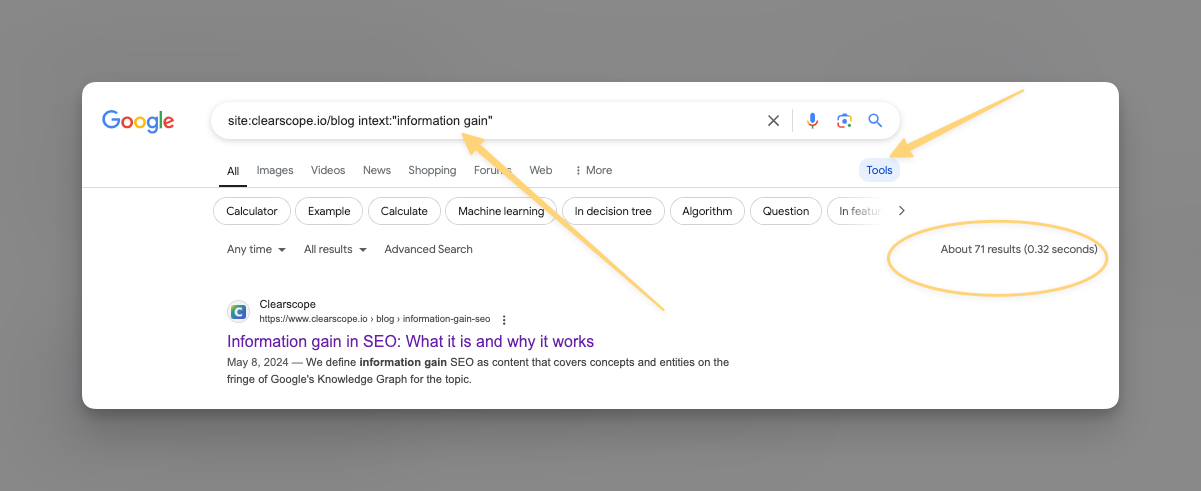
To see the page count, make sure to select "Tools" under the search bar.
And for this method of measuring topical authority, you’ll likely need to use a few standard advanced search operators to get a full look, including:
inurl: This one is great for finding content that includes particular terms in its structure.
intitle: See an example of this below. This one’s useful for finding content with strong relevance to a topic in its title.
intext: This one is helpful for finding content on sites where the word appears in the main content.
allintext: When measuring topical authority, this one really shines. It’s useful when you have a topic that has multiple synonyms, so Google provides results with multiple terms in the body. For example: [Content pruning] and [content auditing] could be considered synonymous search queries.
allintitle: This one is also useful to examine titles when you have a topic that has multiple synonyms, so Google provides results with multiple terms in the title.
Let’s put this together. Here’s what you type into that good ole search bar:
Site:[insert your site or specific site category] intitle: “search phrase”
Example: site:clearscope.io/blog intitle:"topical authority"
My favorite way to do this?
Use the intitle operator first.
Then, use the intext operator to get a count of your indexed pages that include that topic in the body, to make sure you didn’t miss any pages that are related.
And there’s your count. Go you!
Bernard Huang’s topical authority analysis
I can’t talk about measuring topical authority without mentioning Clearscope’s founder Bernard Huang’s take.
Here’s how he measures it using an AI assistant:
Export your top search queries from Google search console or Clearscope
Cluster them by topics using LLMs (like ChatGPT, Gemini, Claude, or Perplexity)
Compare your aggregate traffic compared to head term of that topic’s search volume

Here's what ChatGPT thinks about Clearscope's areas of authority.
Want to save even more time? It can get even simpler than this.
(And what founder doesn’t love efficiency and simplification? Bernard is no different.)
Just ask your favorite AI assistant the following: What topics is [your brand or domain] authoritative in?
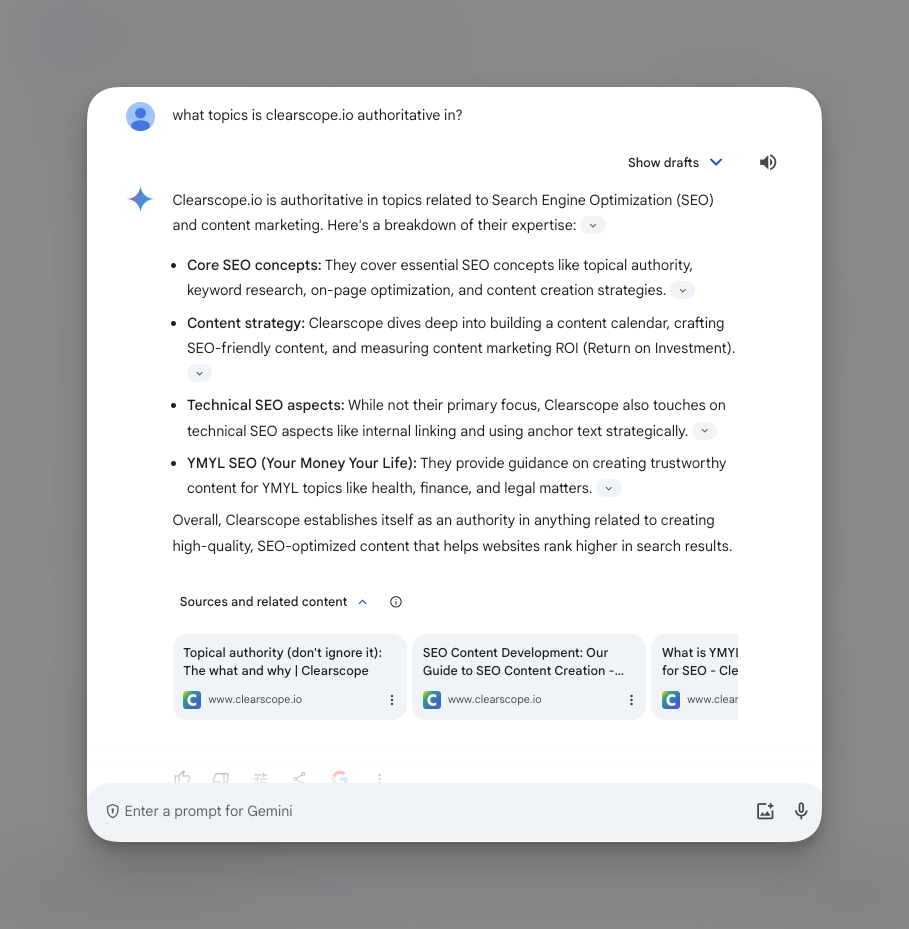
Here's what Gemini thinks about Clearscope's areas of authority.
Here’s how I measure topical authority
Hang with me here: It’s about to get very manual.
And because this is fairly manual, I only provide this report bi-monthly or quarterly to stakeholders (it depends on the team or client).
Here’s what you’ll need:
An SEO tool that can analyze keywords that your competitors are ranking for and their estimated ranking positions.
Your top 3 to 5 content competitors that you’d like to outrank (I like to choose 3)
The seed keyword (or primary entity) for your target topics
Google sheets
Yep, that’s it.
Step #1: Pull total ranking keyword data for your site
Use Google Search Console for the most accurate ranking estimates.

You can pull the ranking data for your own site via Google Search Console, which shows accurate average positions for your site. And use your favorite traditional SEO tool, like Semrush, Ahrefs, or Moz, to pull competitor data estimates.
Step #2: Pull total ranking keyword data for your top competitors
Use your favorite keyword tool, like Clearscope Topic Exploration, Semrush, Ahrefs, or Moz, to get competitor estimates.
Step #3: Estimate keyword counts by positions
For each site, estimate the counts of keywords for your target topics for the following positions
#1 positions
#1-3 positions
1-10 positions (Page 1 rankings)
Any SERP features
Technically, if you want to save some time, you can skip this step and still get meaningful information in comparison to your competitors—without detailing ranking positions.
Step #4: Do the math
Now, you’ll need to record the following for each site (including yours) and each target topic you’d like to rank for:
Percentage of ranking keywords in > each individual topic > for each site/competitor > for each position
Compare percentages in that topic to your big competitors—you might be surprised what you find
I’ll show you how this all comes together in two different examples below.

Real-world example #1: KanbanFlow
For example, let’s say you’re KanbanFlow, a small SaaS company that provides project management software tailored to the Kanban method.

Here's an example of what this could look like. We'll dive in deeper into this example below.
Your team wants to build authority in the following broad topics:
[Kanban Boards]
[Project Planning]
[Project Management Software]
[Task Management]
Your team wants to determine the topics you might already have authoritative content in, along with where to put marketing resources the next quarter for building new content clusters.
For this analysis, let’s say you choose your top 3 content competitors to be real big heavy-hitters in this industry: Monday, Asana, and Trello.
For each of these topics you’re going to determine and record the following:
Total count of ranking keywords your site has for your selected topics above in the #1 position, 1-3 positions, 1-10 positions, and any SERP features
Total count of ranking keywords your 3 competitors have for those same topics in the #1 position, 1-3 positions, 1-10 positions, and any SERP features
Next, do the math.
Discover your percentage of keyword topic ownership in your core topics.
This is what this would look like:
# of rankings for [kanban] / total number of keyword rankings for domain
You’ll then do this for your competitors and compare % of ownership.

Real-world example #2: Sealed
For this example, let’s look at a simplified analysis.
Let’s say you’re Sealed, a small climate tech company that provides energy efficiency projects to homeowners and support to contractors.
Your team wants to build authority in the following broad topics:
Heat pumps
Insulation
Sealing
And let’s say your top content competitors in the home improvement space that you want to measure your site against are:
Bobvila.com
Angi.com
You’re going to determine and record the following:
Total count of ranking keywords your site has for your selected topics
Total count of ranking keywords your 2 competitors have for those same topics
Next, do the math:
Discover your percentage of keyword topic ownership in your core topics.

This is what this would look like:
# of rankings for [heat pump] / total number of keyword rankings for domain
This illustrates the percentage of the keyword rankings your URL “owns” in total ranking keywords.
And when compared to your competitors, who cover significantly more topics than you do on your site, you have quite a bit of ownership in your target topics.
What this method is good for
Over time, if your topical authority is growing, your percentages in topic coverage should be growing in comparison to your competitors.
And if you’re noticing declines? Well, then you know which topics to invest your time in.
The other thing this exercise is excellent for?
Demonstrating to your stakeholders in a practical way where their “window of topic opportunity” lies.
It can be a struggle to illustrate to clients and stakeholders (with data!) why it may not be to the organization’s benefit to target certain topics over others in the beginning stages of a content strategy.
Obviously, KanbanFlow would have a difficult time owning the topics of [project management software] compared toAsana, its theoretical competitor in this example.
Putting marketing resources here could be wasteful—at least, in the beginnings of a content strategy—because it’s going to be challenging for KanbanFlow to beat their content competitors in that area.
However, KanbanFlow has a very real opportunity to own visibility in topics around kanban practices specifically. And lucky for them, it’s also in their name.
And for Sealed?
A quick analysis demonstrates that—based on percentage keyword rankings in the [heat pump] topic—search engines just might already see this site as an authority in this space compared to Sealed’s larger, more-resourced content competitors.
Also, if anyone can figure out a better way to do this process that is less manual, please hit me up on LinkedIn because I DEFINITELY want to know about it.
5 ways to measure or analyze topical authority with the help of ChatGPT and other AI tools
You can use an AI chat assistant to do some digging into the topical authority for your site.
Here are a few prompts to get you started.
1. Content gap analysis
Use LLMs to help you understand the authority search engines might understand for your site vs. your competitors.
Prompt: Analyze the topical authority of my website on [topics] at [URL], compared to the top-ranking websites for the same topic, including [insert competitor URLs]. Compare the depth of my content against relevant content of my competitors, identify gaps where my topic coverage is weaker or incomplete, and suggest areas where additional content could build high topical authority.
2. Content depth evaluation
Use AI assistance to evaluate the current depth of content in your core topics or related subtopics and ask for additional suggestions for future coverage.
Prompt: Evaluate the depth of my content for [topic] to determine if I’m covering all key subtopics. Here are the key URLs on my site that cover this topic already [insert URL list]. Please keep in mind the following subtopics [insert subtopics] and the following keywords [insert search queries].Next, analyze the content on my site and check if it covers all the essential subtopics under the main topic. Provide insights on whether my coverage is sufficient or if there are important subtopics or FAQs missing that might be affecting my topical authority.
3. Keyword clustering and topic relevance
Use LLMs to help you find missed opportunities in keyword clusters.
Prompt: Help me identify keyword clusters for [topic] to enhance my topical authority and boost rankings. Here is a list of my target keywords that my readers search for [insert target keywords]. Here are the URLs I’d like examined [insert URLs].Next, cluster suggested keywords based on semantic relevance and semantic SEO principles, suggesting how to group them into individual pages or sections on my site.
4. E-E-A-T (Experience, Expertise, Authoritativeness, Trustworthiness) content review
Find out if your content measures up with Google and current search engine optimization best practices.
Prompt: Evaluate the E-E-A-T of my content and provide recommendations for strengthening topical authority. Here is the URL [insert web page]. My target audience is [insert information]. Assess whether my content demonstrates experience, expertise, authority, and trustworthiness. Suggest improvements such as citing authoritative sources, improving author bios, or adding more comprehensive content to boost E-A-T.
What you need to keep in mind for measuring topical authority
In the post-Google-AI-Overviews era, topical authority is a critical part of every SEO strategy.
In my experience, if you build it, it will snowball and grow. Topical authority helps you not only establish strong organic visibility, but also trust in your brand.
But measuring topical authority isn’t straightforward.
Whatever tools or methods you’re using to represent topical authority metrics to your stakeholders, the goal is to establish yourself as the definitive expert on a specific topic (and related topics!) with in-depth content across your content marketing strategy.
At the end of the day, strong topical authority doesn’t just help you rank higher—it helps you align with search intent, build high regard with your audience, and ultimately, drive more conversions.
So keep optimizing, keep learning, and keep building your authority in your niche.
Bonus pitch (lucky you): Clearscope can help you do all three like a seasoned pro.
But don’t just take my word for it...
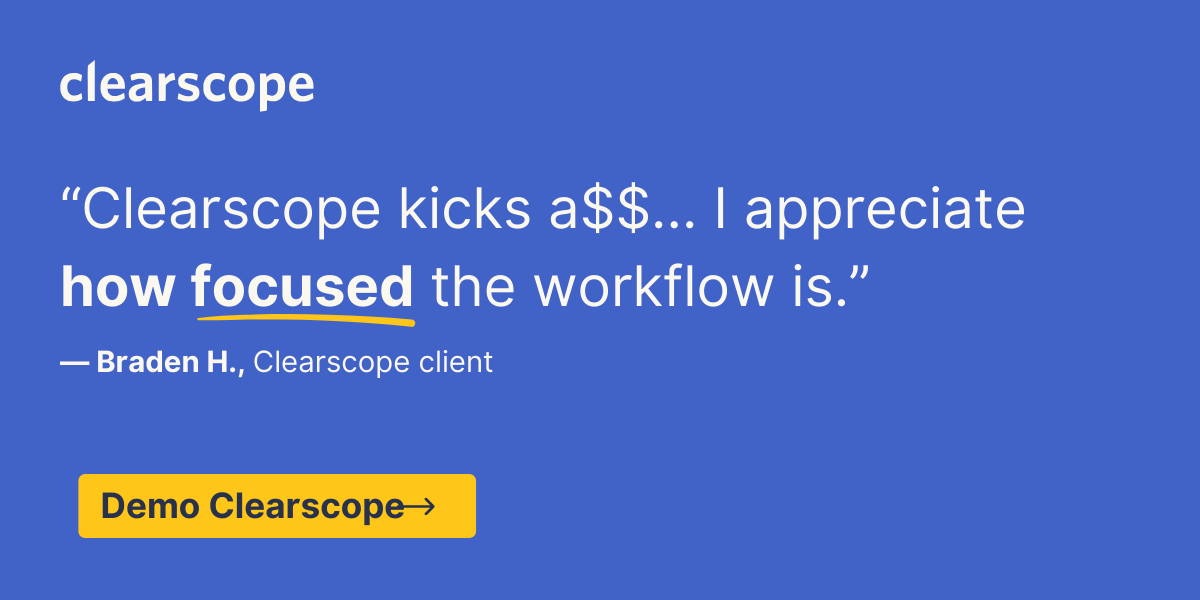
How To Measure and Predict ROI for Your Content Marketing Strategy
Understanding how to calculate content marketing ROI is an essential step in tracking and communicating the effectiveness of your strategy.
Read moreHow to Add Information Gain to Your Content: 3-Phase Plan
In this straightforward, 3-part plan, you'll find out how incorporate information gain into your existing SEO content and test outcomes.
Read moreHow to Find Your Goldilocks Keywords With Search Intent Analysis
Learn how to analyze search intent correctly the first time in this step by step guide. That way, you’re creating SEO content that sharply meets user intent.
Read more